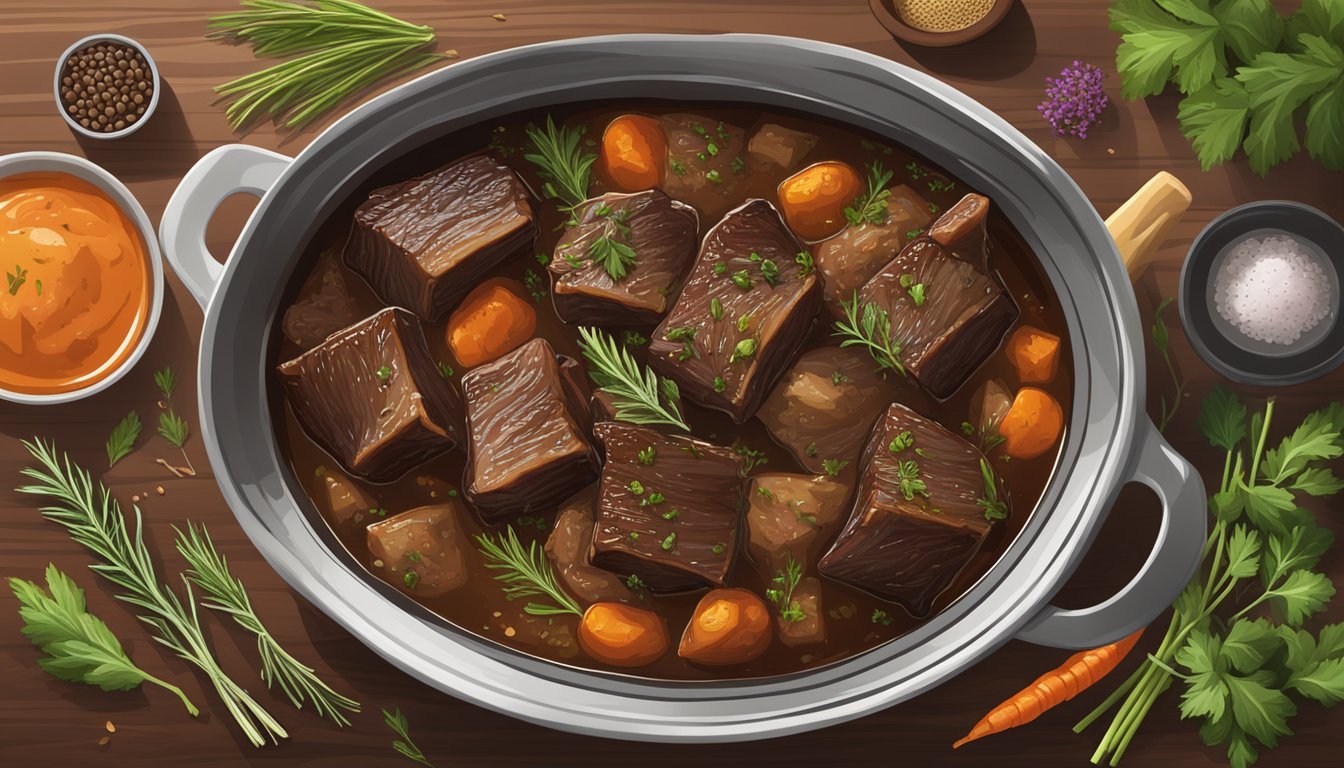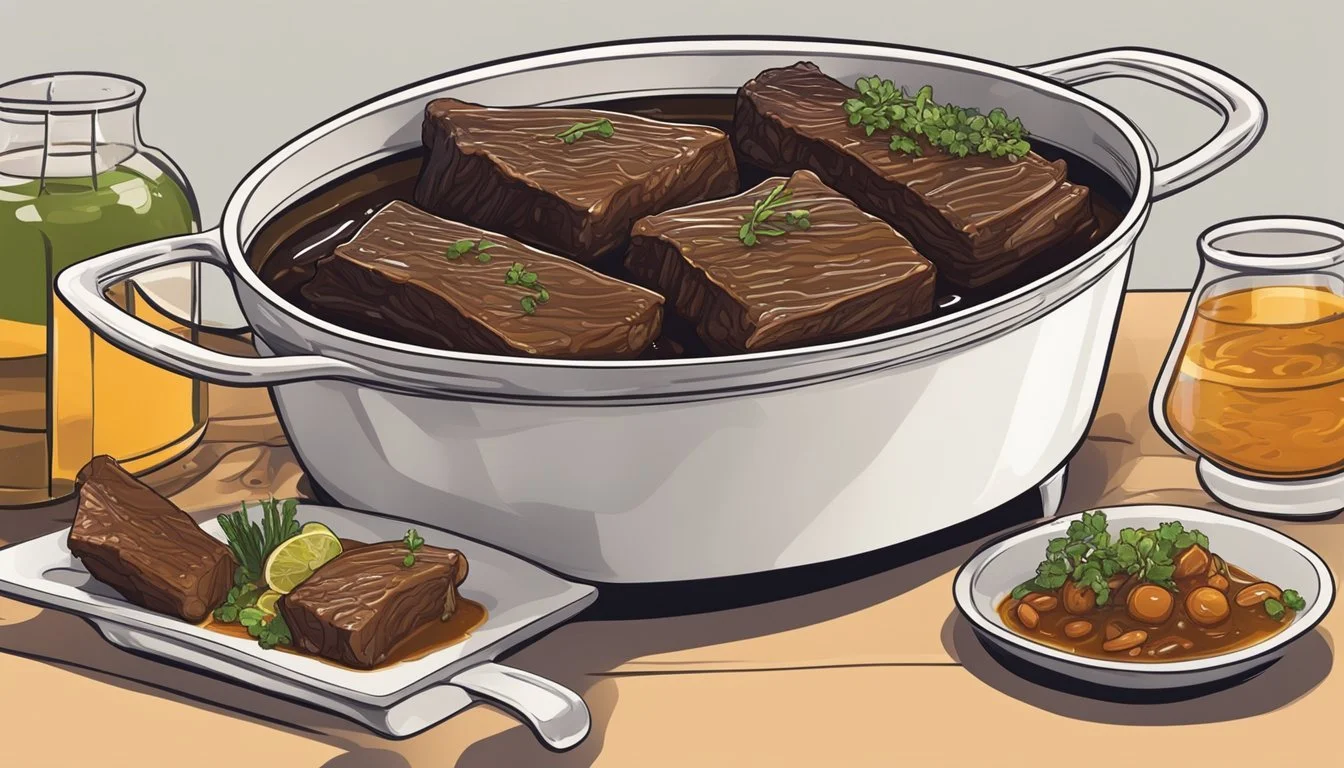Best Way to Reheat Braised Short Ribs
Ensuring Tenderness and Flavor Retention
Braised short ribs are a classic comfort food renowned for their succulence and depth of flavor. As with many slow-cooked dishes, the challenge often lies not in the cooking itself, but in preserving the dish's qualities upon reheating. The key to successfully warming up braised short ribs is to utilize a method that maintains their tenderness and enhances their inherent richness without causing the meat to dry out or lose its savory edge.
One popular approach is to gently reheat the ribs in the oven. By doing so, the ribs are gradually brought back to temperature, ensuring that the fibers of the meat do not contract too quickly, which can lead to toughness. It's also important to reintroduce moisture to the dish, often by adding a bit of the braising liquid or even a fresh splash of broth or wine, which helps to revive the flavors and ensure the meat remains juicy. Covering the dish with foil before placing it in the oven not only aids in heat distribution but also traps steam, keeping the ribs from drying out during the reheating process.
Understanding Braised Short Ribs
Braised short ribs are renowned for their tender consistency and rich flavor profile, making them a favorite for gourmet meals. Proper reheating methods are essential to maintain these qualities.
Importance of Tenderness
Tenderness in braised short ribs is essential. During the initial cooking process, the collagen within the ribs breaks down into gelatin through slow cooking at low temperatures, resulting in a succulent texture.
Maintaining this tenderness when reheating requires:
Gentle heat to avoid toughening the proteins
Moisture to prevent drying out
Texture and Flavor Profile
The flavor profile of braised short ribs is intricate, where savory notes often meld with sweet undertones, sometimes enhanced by a smoky essence. The texture should ideally be juicy and mouthwatering, a direct result of the braising liquid and the meat's fatty marbling. Reheating methods should:
Preserve the ribs' moisture balance
Retain the complex interplay of flavors, without overpowering the ribs' innate delicious taste
Pre-Reheating Preparation
Proper pre-reheating steps are crucial to ensure that braised short ribs retain their tenderness and flavor. These steps help to achieve optimal heat distribution and preserve the integrity of the dish.
Bringing Ribs to Room Temperature
One starts by allowing the ribs to sit out of the refrigerator until they reach room temperature. This process generally takes about 30 minutes. It is an essential step, as it promotes even reheating and prevents the meat from being shocked by a sudden temperature change which can affect its texture.
Preheating the Oven
Preheating the oven is a key move that should not be skipped. For braised short ribs, setting the oven to a moderate temperature, typically between 325°F (163°C) to 350°F (177°C), is recommended. This allows for gentle reheating that can slowly warm the ribs without drying them out.
Selecting the Right Reheating Equipment
The equipment used for reheating plays a significant role in the quality of the end result. One should select a baking dish that will comfortably fit the quantity of ribs being reheated. The dish should be suitable for covering with aluminum foil, which is vital for creating a moisture-retaining environment that mimics the braising process. If opting for a stovetop method, a pan with a tight-fitting lid is ideal to ensure the ribs don't lose their moisture.
Reheating Techniques for Braised Short Ribs
When reheating braised short ribs, maintaining their tenderness and flavor is paramount. The key is to apply gentle heat and retain moisture using one of the following methods.
Oven Reheating Method
Preheat the oven to 325°F (163°C) for conventional reheating. Place the ribs in an oven-safe dish and cover it tightly with foil to lock in moisture. Heat the ribs for about 20-30 minutes or until they reach an internal temperature of 165°F (74°C). You can add a bit of beef broth to the dish to help keep the meat moist throughout the cooking time.
Stovetop Reheating Method
For stovetop reheating, drizzle oil in a large skillet and heat over medium-high until hot. Reduce the heat to medium or medium-low and add the short ribs, possibly in batches to avoid crowding the skillet. If necessary, a splash of liquid – such as beef broth, sauce, or even water – can be added to reintroduce moisture and boost flavor. Simmer the ribs low and slow, turning occasionally until thoroughly warmed through.
Sous Vide Reheating Method
Heat a water bath using a sous vide machine to 165°F (74°C). Place the short ribs in a plastic bag, removing as much air as possible, and seal. Submerge the bagged ribs into the water bath, ensuring they are fully immersed. Reheat gently for about 45 minutes to an hour. This method heats the ribs evenly without losing moisture, preserving their succulent texture.
Additional Reheating Options
While the oven, stovetop, and sous vide are the most common techniques, you can also consider others. For instance, wrapping ribs individually in foil and reheating on a low-heat grill can be just as effective. Regardless of the method, always reheat until the internal temperature meets food safety standards, typically reaching 165°F (74°C).
Accompanying the Short Ribs
The perfect accompaniment to braised short ribs enhances both the flavor and presentation of the dish. Choosing the right sauce, liquid, and sides can elevate the meal to an exquisite dining experience.
Sauce and Liquid Considerations
When reheating braised short ribs, maintaining the tenderness and flavor profile is paramount. Sauces and liquids play a crucial role in this process. A leftover marinade or the braising liquid itself, ideally enriched with beef broth and red wine, can be reduced to create a sumptuous sauce that complements the ribs while providing moisture during reheating. To ensure consistent taste and prevent drying:
Reintroduce a portion of the braising liquid or marinade before heating.
Cover ribs with foil to lock in moisture.
Sides to Complement the Flavor
Selecting sides that echo the rich flavors of the short ribs creates a harmonious plate. Savory mashed potatoes offer a creamy texture that contrasts delightfully with the meat's succulence, while roasted vegetables add a slight caramelized note and provide a nutritious balance. For best results:
Prepare mashed potatoes with a touch of garlic or truffle for an enhanced flavor.
Choose a variety of vegetables such as carrots, parsnips, and Brussels sprouts for roasting to incorporate a range of textures and tastes.
Food Safety and Storage
Ensuring the safety and quality of leftover short ribs requires careful attention to storage and reheating techniques. This section focuses on the key aspects of handling leftovers, such as methods for storing, defrosting, and ensuring the ideal internal temperature whilst avoiding cross-contamination.
Storing Leftover Short Ribs
After cooking, short ribs should be stored in an airtight container within two hours of preparation to prevent bacterial growth. They must be placed in the refrigerator and consumed within three to four days for optimal safety and taste. Freezing is an option for longer storage, extending their life for up to three months.
Proper Defrosting Techniques
When ready to reheat beef short ribs, thawing must be done safely. Defrost leftovers in the refrigerator, under cold running water, or in a microwave using the defrost setting. Never thaw meat at room temperature, as this can allow bacteria to multiply rapidly.
Checking Internal Temperature
Reheat leftovers to an internal temperature of 165°F, as verified with a meat thermometer. This ensures any potential bacteria present are destroyed and the short ribs are safe to eat. Insert the thermometer into the thickest part of the rib to check the temperature accurately.
Avoiding Cross-Contamination
Always use separate utensils and cutting boards for raw and cooked foods to avoid cross-contamination. Wash hands, surfaces, and tools thoroughly with hot, soapy water before and after handling the leftover short ribs. Safe practices prevent the spread of bacteria and maintain food quality.
Final Thoughts
Reheating braised short ribs requires a method that retains their moisture and tenderness. The oven emerges as the preferred option, ensuring even, gentle warming. For best results, preheat the oven to 350°F and transfer the ribs into an oven-safe dish. They recommend introducing a small amount of liquid, like beef broth, to keep the ribs succulent.
Microwave alternative: Although not ideal, they can use the microwave in a pinch. It's crucial to cover the dish and use a moderate power setting to prevent the fibers from toughening.
When using a stovetop, they advise cautious heating. Adding oil to a pan, they should warm the short ribs over low to medium heat, careful not to overcook.
Key tips for stovetop reheating:
Use a pan of suitable size for the ribs.
Begin with sizzling oil before adding the short ribs.
Regulate heat to avoid burning.
Restaurants often employ these methods, valuing the quality of reheated ribs. Anyone can emulate this at home, ensuring that their leftover braised short ribs remain enjoyable as if freshly cooked.
For those who appreciate precision:
Oven Reheating: Preheat to 350°F, cover with foil, and reheat for 20-30 minutes.
Stovetop Reheating: Heat oil, then add ribs on a low medium heat, flip occasionally.
Microwave Option: Cover with wrap, use moderate power, heat in short intervals.
Reheating should be done until they warm the ribs through without drying them out, preserving the delectable qualities that make braised short ribs a sought-after dish.





